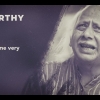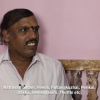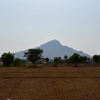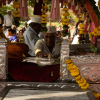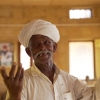Sharon Lowen is one of the leading Odissi performers today. She grew up in Detroit in the United States and was trained in puppetry and ballet very early in life. She also learned Manipuri under Minati Roy, and then, in 1975, came to India on a Fulbright scholarship to continue with her Manipuri training. Later she was trained in Mayurbanj Chau and Odissi. Lowen was the first woman solo performer of Maurbhanj Chau and played a major role in bringing international attention to the dance form. She has performed Odissi on national and international stages and has also choreographed and performed for films and Doordarshan. She has authored books titled Odissi and Dancing Phenomenon: Kelucharan Mohapatra.
Following an edited transcript of the video interview with Sharon Lowen conducted by Madhur Gupta in Delhi, 2018.
Madhur Gupta (MG): All through these years—you started learning Odissi from Kelu Babu (Kelucharan Mohapatra) from 1975 onwards, and you went to the US and then came back—you also had a major concert in 85 when you and Kelu babu and other musicians went on a major tour—so tell us about your relationship with your guru?
Sharon Lowen (SL): Well, as I said, I came back to India in ‘81 after a break. Before I left, the music that Guruji had recorded for my final recording, in which he had so generously recorded half a dozen dances that I had not even learnt, because the musicians knew them well, and there was studio time and musicians’ fee, and he just told them to keep recording. And they did that. Very unique. He said to me: I want you to have them. You will learn these items later and it will save you money. Our relationship was absolutely wonderful. My daughter was born on December 26, 1981. Two months later, Guruji was scheduled to give a workshop in Delhi, after which he was planning to leave on an extended tour accompanying Sanjukta Panigrahi. Guruji was so kind and so generous. I scheduled a programme in Delhi and in Culcutta, and I did still half Manipuri and half Odissi. Guruji played the maddala. Singhajit Singh (Manipuri) did not accompany or see my programme, but I had musicians at that time. The irony was that, for some reason, Guruji had cancelled the workshop. But my programmes were still scheduled. I had intended that that workshop would whip me back into shape and, as it was, my preparations were not as intense as it would have been with the workshop. But the critics were unbelievably kind. I got great reviews. He was very good about doing that. Another thing was that because my learning with him was in spurts—because I was not staying here all the time and because at that time he was jet-setting around various cities—I always took a lot of notes. At first Guruji would say: Just learn the dance without the notes. But I would be going back and forth, and in between I would be checking notes, and so he had a lot of confidence in them. Then whenever there would be workshops in different places, and there would be some difference in what he taught, he would ask me to get the notebook. Then in ‘84 I organised my tour—this was actually during the Festival of India—one of the performances was at Santiago State University, UCST. The professor asked an Indian, Porna Patnaik, if he would be willing to host the troupe. When Porna found out who the group was, the entire Odia community went ballistic. So, when we stayed with Porna, once after dinner, a young lady came up to Guruji and said: Are you really K.C. Mahopatra? He was like his usual self, very modest and all. And the girl sais: My father says the real Kelucharan Mahopatra would never accompany an American.
MG: After this tour a lot of things changed.
SL: Life itself changed.
MG: Yes. In terms of your career, and also, as you always say, after 15 years there is a shift.
SL: Yes, I guess, it was about 15 years. After this tour, and touring around India with Guruji, and many festivals and things that I had done, this was the time when I was recognised as a classical Indian dancer at the level of my peers. Obviously still there were people who would ask if I knew how to wear a sari. And I would say I have been wearing it twice as long as you have been alive. Also, there are half a billion women who can wear saris. It is not a big achievement. But it is like that thing with Odias in America. You should visit Konark. I will tell you. Once I was dancing in Kuwait. The Odia community there gave me a dinner. It was a very different feeling. Just like every other classical dancer that you are happy to have with you and performing. It shifted from that. So, really that acceptance came gradually, solid commitments came gradually. I did half Odissi and half Manipuri at Kalamandir. It was a wonderful event. And that was in ‘78. Vimal Das once said: Sharon, you are already in the top ten per cent of classical Indian dancers. And you will never be recognised as such. And I was fine with that. Because I was not doing it for recognition, I was doing it because I loved doing it.
MG: But then you were recognized. After the ‘85 tour, Kelu Babu said …
SL: Yes, there was an interview by Bombay Talkies, which Rajat Kapoor did. In that Guruji had mentioned: I have trained five hundred dancers. 50 of them are performing. Five of them I can recommend to perform anywhere in the world. And Sharon is one of them. The only reason I am doing Odissi is because of him, because of his encouragement, and his teaching. And, secondly, what kept me [going] is that I loved the learning and the sharing of the learning, of going into texts. I just loved approaching something new. Performing poetry that perhaps people are very familiar with, maybe as part of their daily prayers and seen interpreted in their own classical styles. And I loved taking it, not knowing that, and loved giving it a meaning and doing something that is worthwhile. Gradually I started doing my own choreography. The first production for Central Production Centre was a combination of Odissi, Bharatanatyam and Kathak. I had invited Bhuvaneshwar Misra as my violinist. When they found out, they were thrilled because they needed an overall composer. And gradually I started experimentations in my work. And then when Guruji was in Delhi, sometimes he would come, and I would show him what I had done, and he would give suggestions. And I could get that confidence. I would not have done my choreography if I had been at his side. And it meant that from the late 80s I did not have the benefit of his correction and eye. But I always had his blessings.
MG: You have been associated with Odissi for four decades now.
SL: I have been here 45 years now.
MG: So more than four decades! What do you think has been the change, the shift in style, in terms of technique, and the intention?
SL: All of these changed, everything changes, everything should change, everything must change, everything will change.
MG: Yes, but how has it changed?
SL: First of all, the structure that Guruji had created … When he started, as we all know, the Odissi programmes were half an hour. In the era where I learned and performed, performances were two and a half hours or at least two hours. You would do one hour, and in the interval, change the costume and then you would do a shorter second half. When I toured in Malaysia, the programmes lasted two and a half hours. And if I was ten minutes short, then I was told to add another item the next day. So, one thing was that the programme was longer. That means it was structured differently. It was the same with Bharatanatyam and other dances. So, after your mangalacharan (invocation) then you do battu, then you do your pallavi (different items in a typical Odissi repertoire). Nowadays, you do one or the other, if you are lucky. Then you might do another abhinaya (item that focuses on emoting). Then, maybe, end the first half of the programme with something like Dashavatara (an Odissi dance compostiton). Then you got another pallavi, a long Govinda (a Gita Govinda composition), and then mokhiya (item in a conventional Odissi repertoire).
Today after a programme if someone says, ‘I am tired’, I would think, ‘When did I even dance?’ It seems like a snippet compared to whatever we used to do. The other thing is speed. Things have tended to get faster, but it depends. I think it is more the speed of the shorter programme which is tailored. So, basically, when you have to have the top of the hit parade, you go straight there; that is quite different from creating a frame and building from there in the earlier, longer concerts. For instance, when we did mokhiya at the end of a performance, we really had built and created and taken the audience somewhere and then taken them somewhere else, and then finally you are doing mokhiya. Now it is kind of funny to be saying, ‘and we conclude with mokhiya’, the culmination of what we have achieved.
Instead of the chokha position with the solid bent that is expected of a dancer in solid form, and who is young enough to do it, now everyone has the feet closer, with a slight bent in the knees, which is not a strain and doesn’t require rigorous practice, and is something that is acceptable in somebody past 60. And the other thing in the basic technique is the tribhanga, the triple bent, with hip deflected to the side. Now there is a tendency, rather than the flat at the hinge going sideways, now there is a bent and, so, one is bending forwards at the hinge. From the front, visually, you don’t see the difference. What it does is it projects the chest forward. The problem with that position is, you have a nice position straight forward, but actually you are not able to move your torso side to side. You have to have your chest back flat in order for the ribs to go side to side. So, the wonderful, sophisticated, nuanced movement of the torso that Guruji had is virtually impossible to do now when you are pushing out forward. So, you see the tribhanga, and people move. You don’t see the torso movement which was delicious, and set Odissi so much apart.
In Odissi, just like in every other classical style, there is a tendency to move away from solo presentation. There are very good reasons. Number one, the dance is popular. There are a lot of students, and there are not many opportunities for soloists. Everyone gets to dance when you are in a group. You don’t have to be that great. You certainly don’t have to be good enough to hold an audience for long by yourself. The demands of the solo artistes are such that … it is hard. On the other hand, the unique quality of Indian classical dance to actually evoke ras, and to create a margi experience that is metaphysical, is something that, in the natyadharmi (conventional) tradition, [only] a soloist can successfully present. When you have a group, you have a very entertaining, and more towards the spectrum of lokadharmi (realistic), presentation. It is, basically, like you are coming to Amar Chitra Katha. And we love Amsar Chitra Katha. Everyone loves them. My daughter read every one of them. They are a good place to start. But the thing is, for most people it would end there. So, you are not going to get the metaphysical aspect. You are not going to get the opportunity to understand that you need to give up your self-centred nature to connect with paramatma. It is not just a kind of bhakti itself, but it is the understanding or the wisdom of what that bhakti is. If you understand that then you can ideally get through the performing arts.
MG: Since we are talking about the change in the style and techniques of Odissi, what is the parameter of Odissi? What is the true bani (style) basically?
SL: It is a wonderful question. But there isn’t a simple answer. What is in style, what is out of style? All of the classical traditions are neo-classical. They have been reconstructed in the last hundred years. And Odissi is very much a part of that tradition. And it is moving forward. So, what is out of style? In the generations of gurus who participated in jayantika (the group of Odissi gurus who met and discussed the restructuring of Odissi in 1964), they had agreed on what was style, and afterwards there was a slight shift, and the shift meant that the parameters were slightly expanded. So, in Kelu Babu’s style, the hips don’t move, in Debaprasad’s style, they do. In Kelu Babu’s style arms are held, elbows parallel. While in Debaprasad’s style, arms are held a little bit higher. However, there are other teachers who didn’t have the same framework or foundation of the ones who participated in jayantika, and [they] kind of created their own interpretation, and are generally considered beyond the pale. But not by everyone. They had followers. They had recognition. So, some people would say: Yes, yes, that is within the pale. In Odissi, or anything else, the core thing is the intention and not just what you would see. So, one has to make choices about what one thinks is in or out of the pale. If there are changes in costume … I remember once dancing in Odissa, and I didn’t use the upper arm ornament. And there was an objection. That is beyond the pale. You must wear it. My feeling was, you know, as I become older, I don’t want to be as ornamented as a young artiste. But you can see the argument both ways.
There are gurus like Pankaj Babu, a great choreographer, a fine teacher, but had very few students. One reason was that he was very hard on them. And, also, there are teachers who are very concerned about their students’ possibility of not doing their art properly in some way. Kelu Babu, he was my guru, so I follow his perspective. He would generously give everything. He totally knew that some of the students would cheat, he wasn’t concerned about it. Because he felt that the art would rise above abuse. So many people doing, and not doing properly—they are not going very far. And those who are doing would rise up. So, I believe in that. So, what is authentic, what is correct, it will sustain.
MG: Can we talk about your choreographies? You have done some very interesting choreographies. Where do you do get the inspiration for these choreographies, and how far are they inspired by your guru, and what new additions have you made?
SL: I never created anything just because I wanted to make something new. I have only created things because of the situation, time, space, whatever. So, for instance, I have done many, many programmes with Doordarshan, and, therefore, many choreographies, bringing together poetry by Raskhan and Vanamali. Raskhan’s poetry done in Kathak on exactly the same theme as the Vanamali poetry. So, I would then choreograph. I would choreograph several of Vanamali’s shorter poems. Then there were also times that Doordarshan did a programme where I did a chorography to Dogra, a choreography to Bengali, etc. Some things were like that. I created things in languages for specific programmes. One of the most successful programmes for Doordarshan was my ‘Panchnayika’, five heroines of Kalidasa. We took the idea that for a national programme of dance, rather than simply taking something that has been choreographed for stage and recording it, we would take the opportunity to create something for that media. Taking five nayakis meant we could have five sets of costumes. And in each of these we would have text and one pallavi portion. It was such an effort of love; we spent almost a month in between each segment when we could assemble everybody that we wanted to have as part of it. For the first one, which was done outdoors, we had to wait till the tall grass grew on the Yamuna riverbed, so I could be out there, doing my thing. That was quite exciting. Then the other thing is creating things for festivals such as Tansen Tyagaraja, Ramnavami, etc. So, you create for a particular event. Obviously, in Varanasi, when I danced for Swatch Ganga, Sankatmochan, etc., I create invocations to Ganga and to Shiva, adding slokas to bilahari pallavi using dyanaslokas on Hanumanji. And, of course, there was a time when I was going quite a bit to Kerala, dancing for Kalamandalam Diamond Jubilee, dancing in Nishagandhi [Nishagandhi auditorium, Tiruvananthapuram] and this and that and whatever.
So, first thing, doing mangalacharan on Padmanabhan [for the dance programme in Tiruvananthapuram]. Obviously, one can always do for Ganapati and Saraswati. But why not create for the place? And then taking Aliveni by Swati Tirunal, because this is a very similar kind of sringar. Then next time, ok, my sringara is appreciated, let me do vatsalya. Then do a new interpretation of Omanathingal [a Swati Tirunal composition]. And at the end of it, the mother’s lullaby is sung to herself as the child goes off with the guru. The only time that I have done something in English was for the 200th anniversary of the oldest synagogue in Mumbai, where I took the song of Solomon from the Bible, which uses the metaphor of human love for the divine.
MG: So, basically, you are saying one of your main contributions to Odissi is the introduction of various languages.
SL: Not necessarily various languages, that is just a part of it. I have done languages. I have done things that are specific to different locations. I have done programmes for different events and different crowds. Then I have danced along with Kamalini Dutt in Khajuraho on Shivaratri in different styles. I choreographed that. And the choreography that I did emphasised on pure dance because that is like fun. That is like playing with geometry. I enjoy that. But I enjoy more taking a text, for example, Balamuralikrishna’s Omkarakarini, which is now my signature piece that I use at the end. Basically, my choreography has always been done because the performance elicits it. So, for instance, the Shivstuthi, I had done that at Mukteshwar. Then I repeated it in Shivsagar.
MG: What is your advice to the young, upcoming artistes?
SL: I believe that for everything in life you have to pay one price or another, whether it is your time, whether it is your money, whether it is your ethics—you have to decide your prices. I feel that if you love the dance then you should dance. I think that if you want to continue to love the dance there are two things. One, if you have nothing to do, so you find that the wolf at the door motivates you to do better in your career as a dancer. Otherwise, I would say if you love dance and want to continue loving it, have something else to take care of your economic survival so that you don’t wind up hating the dance because of having to compromise either aesthetically or in any other way. For instance, if you love to dance, but you wind up having to dance in productions to earn money, and that you don’t like, it would be better to have some job, but, you know, it depends, obviously. And the question of time … I think one can always find time. Whether it is getting up early in the morning and doing your riyaz (daily practice), you can find a way. But don’t expect your parent to be your patron.
--------------------------------------------------------------------------------------------------------------









